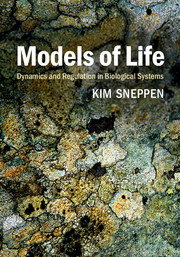Book contents
- Frontmatter
- Contents
- Preface
- 1 Life from a physics perspective
- 2 E. coli as a model system
- 3 Dynamics of regulatory links
- 4 Statistical mechanics of phage λ
- 5 Diffusion and randomness in transcription
- 6 Stochastic genes and persistent decisions
- 7 cis-Acting gene regulation and epigenetics
- 8 Feedback circuits
- 9 Networks
- 10 Signaling and metabolic networks
- 11 Agent-based models of signaling and selection
- 12 Competition and diversity
- 13 Evolution and extinction
- Appendix
- References
- Index
9 - Networks
Published online by Cambridge University Press: 05 October 2014
- Frontmatter
- Contents
- Preface
- 1 Life from a physics perspective
- 2 E. coli as a model system
- 3 Dynamics of regulatory links
- 4 Statistical mechanics of phage λ
- 5 Diffusion and randomness in transcription
- 6 Stochastic genes and persistent decisions
- 7 cis-Acting gene regulation and epigenetics
- 8 Feedback circuits
- 9 Networks
- 10 Signaling and metabolic networks
- 11 Agent-based models of signaling and selection
- 12 Competition and diversity
- 13 Evolution and extinction
- Appendix
- References
- Index
Summary
Convergent computation
The examples of small networks in previous chapters typically consisted of two to three proteins, which together sensed and governed one particular function in a living system. In this and the next chapter we will zoom out and view larger-scale network properties, with the guiding perspective that these networks, in the end, form some functional coherent whole. Figure 9.1 illustrates this main philosophy by showing the regulatory network of two evolutionarily unrelated temperate phages, the enterobacteria phage 186 and the λ phage. Apart from having different numbers of proteins in the outer parts of the networks, the two networks look remarkably similar. Thus, the functional requirement over-rides the randomness of evolution: convergent evolution has directed both phages to the same “computational” design.
The visual similarity of the two networks shown in Fig. 9.1 can be formalized using a network alignment algorithm [157], a comparison that is based entirely on the wiring diagram and the sign of the regularity links. These signs are indicated by different colored links, with green links referring to activation of the production of one protein due to the activity of another, and red links to an inhibition of the downstream protein.
Importantly, in order to align the networks, one needs to take into account indirect regulation, where one identifies a repression of a repression with an activating link.
- Type
- Chapter
- Information
- Models of LifeDynamics and Regulation in Biological Systems, pp. 177 - 204Publisher: Cambridge University PressPrint publication year: 2014



